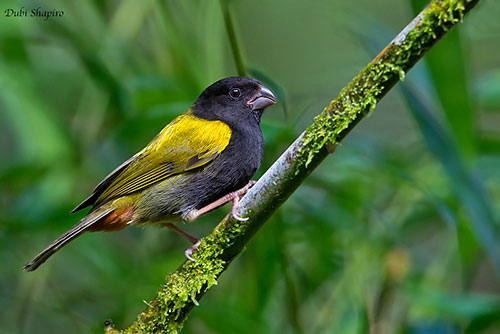
The female has olive head and breast with fine dark grey spotting. She has paler back and wing-coverts, but the carpal patch is bright yellow.
The underparts are mostly grey with pale olive wash. The undertail-coverts are rusty but paler than in male. She has horn-coloured bill (not black).
The juvenile resembles female, but it has reduced yellow on wings.
RANGE:
The Yellow-shouldered Grassquit is found only in Jamaica. It is most common near Ferry River and in dry limestone woodlands.
HABITAT:
The Yellow-shouldered Grassquit occurs at forest edges and in montane evergreen forest. It is common in hills and mountains, and also frequents roadsides and gardens. It is rarely seen at low elevations, but the species occurs from sea-level to 1,800 metres.
CALLS AND SONGS: SOUNDS BY XENO-CANTO
The Yellow-shouldered Grassquit is known for at least four local dialects. The call is a series of five descending notes “chi-chi-chi-chi-chi” with an echo-like quality.
BEHAVIOUR IN THE WILD:
The Yellow-shouldered Grassquit feeds mainly on seeds and small fruits. It usually forages in pairs or in family groups.
It forages at forest edges, in gardens and shrubbery. It feeds on seeds of various plant species and usually low in bushes and trees.
The Yellow-shouldered Grassquit nests in a well-hidden, dome-shaped nest, among the vegetation.
It is sedentary in Jamaica, but it may perform altitudinal movements to the lowlands in winter.
The flight is easy and agile, slightly undulating. It only performs short-distance flights throughout the island.
REPRODUCTION OF THIS SPECIES:
The breeding season takes place between March and September, with the egg-laying mainly from March to July.
The Yellow-shouldered Grassquit builds a domed nest with woven grass, twigs and down, and there is a side entrance. This structure is placed in tree or bush, usually well-hidden in the vegetation, often among epiphytes or under bromeliads of genus Tillandsia, in citrus bushes or under the canopy in cedar.
The female lays 3-4 white eggs with dark speckles and spots around the broader end. The chicks have grey down.
Even after the hatching, the female often adds materials to the exterior of the nest, probably for better camouflage.
PROTECTION / THREATS / STATUS:
The Yellow-shouldered Grassquit has restricted range in which it is fairly common. The population is suspected to be declining, due to habitat destruction.
However, the species is not globally threatened and the Yellow-shouldered Grassquit is currently evaluated as Least Concern.
Fr: Sporophile mantelé
Ang: Yellow-shouldered Grassquit
All: Goldbug-Gimpelfink
Esp: Semillero Jamaicano
Ita: Erbero spallegialle
Nd: Jamaicagrondvink
Sd: gulryggig gräsfink
Photographer:
Dubi Shapiro
Dubi Shapiro Photo Galleries & Dubi Shapiro's Pictures on IBC
Text by Nicole Bouglouan
Sources:
HANDBOOK OF THE BIRDS OF THE WORLD Vol 16 by Josep del Hoyo- Andrew Elliot-David Christie – Lynx Edicions – ISBN: 9788496553781
BIRDS OF THE WEST INDIES – by Herbert Raffaele, Kristin Williams et Tracy Pedersen – Helm – ISBN: 9780713649055
A Photographic Guide to the Birds of Jamaica De Ann Haynes-Sutton, Yves-Jacques Rey-Millet, Audrey Downer, Robert Sutton – Editeur: Bloomsbury Publishing, 2010 – ISBN: 1408133229, 9781408133224 – 336 pages
Wildlife of the Caribbean de Herbert A. Raffaele, James Wiley – Editeur: Princeton University Press, 2014 – ISBN: 1400851696, 9781400851690 – 304 pages
Neotropical Birds – Cornell Lab of Ornithology
Yellow-shouldered Grassquit
Loxipasser anoxanthus
Passeriformes Order – Thraupidae Family
INTRODUCTION:
The Yellow-shouldered Grassquit is endemic to Jamaica where it occurs in forests and woodlands in hills and mountains. It feeds on seeds and small fruits, and nests in a dome-shaped structure concealed among the vegetation.
The Yellow-shouldered Grassquit is fairly common and widespread throughout its restricted range, and the species is not globally threatened.
DESCRIPTION OF THE BIRD:
Biometrics:
Length: 10-11,5 cm
Weight: 10,5-12,5 g
The Yellow-shouldered Grassquit adult male has yellow-green mantle and back to tail. The upperwing is greenish with bright yellow wing-coverts and shoulders. Flight-feathers and rectrices are dark grey with yellow edges.
Head and underparts are black to belly and flanks. The undertail-coverts are rusty. Belly and flanks are mostly dark grey, whereas breast and head are black.
The black, thick bill has rounded culmen. The eyes are dark brown. Legs and feet are pinkish-grey.
